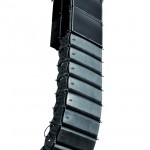 This second part of our line array series deals with the physical aspects of such sound systems. Quite a complex subject yet we have tried to give you a comprehensible access.
This second part of our line array series deals with the physical aspects of such sound systems. Quite a complex subject yet we have tried to give you a comprehensible access.
The basic problem of every sound reinforcement system for large venues is the fact that an individual speaker cabinet cannot supply the complete audience with the required sound pressure level. Even if the audible transmission range between 20 Hz and 20 kHz is separated into five or more different speaker sizes, the necessary characteristics required for audiences with thousands or even a hundred thousands of people cannot be produced – even with the latest technology.
Furthermore, destructive interference occurs even when using only two speakers at once. Interference occurs when sound waves from two different sources overlap and lead to undesired amplification or elimination of parts of the frequency range. The aim of every sound reinforcement system is to minimize destructive interference and to provide the desired signal level at every position in the audience are.
For reaching this aim, speaker clusters were used for a long period of time where several technically identical speaker systems are horizontally and vertically grouped together. Due to sophisticated cabinet constructions and the use of horns in front of the individual drivers, the efficiency, i.e. the realistic electric power converted into sound pressure level, could be increased while reducing the interference areas within the crossover areas between the individual speaker systems to an acceptable level and thus getting closer to a physically ideal point source.
The sound pressure level is reduced by 6 dB for every doubling of the distance from the speaker system, although this only applies to ball waves, i.e. undirected sound sources. Especially in closed rooms, a point is very fast reached where the diffuse sound, i.e. the sound reflecting from the walls and ceiling, reaches the same level as the direct sound from the speaker system. From this point on, the destructive interference is so strong that the acoustic performance can only be recognized in a strongly falsified manner. This distance is referred to as critical distance. One solution is applying delay lines where the transmitted signal is “refreshed” before the critical distance, thus enabling a large or longer audience area at large venues. Nevertheless, the delay speakers must reproduce the signal with a delay as the speed difference between acoustic and electric signal transmission is already audible from only 20 meters away. This is where the name “delay line” comes from.
Another disadvantage of this procedure is the significant sound level loss even among the first meters of the audience area. According to the already cited formula, the sound pressure level at eight meters distance is only one eighth of the level in one meter distance from the speaker system clusters. Often, this problem was solved by more volume which is not only a health hazard in the stage area, but may also have a negative effect on the sound quality and sound level on the stage and which can no longer be recommended with today’s emission guidelines.
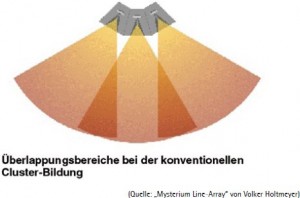 Line arrays are the next logical step in this chain of cause and consequence. With line arrays, it is possible to minimize the basic problems of conventional cluster systems. With line arrays, it is possible to minimize interference between the vertically aligned speaker systems by a vertical dispersion of less than 15°, to increase the coverage and to keep the sound pressure level constant for the maximum number of people in the audience by curving the system, i.e. setting the individual components at a specified inclination angle. Furthermore, line arrays can realize a larger horizontal dispersion angle than horn systems.
Line arrays are the next logical step in this chain of cause and consequence. With line arrays, it is possible to minimize the basic problems of conventional cluster systems. With line arrays, it is possible to minimize interference between the vertically aligned speaker systems by a vertical dispersion of less than 15°, to increase the coverage and to keep the sound pressure level constant for the maximum number of people in the audience by curving the system, i.e. setting the individual components at a specified inclination angle. Furthermore, line arrays can realize a larger horizontal dispersion angle than horn systems.
In order to realize this, some physical problems need to be solved. While the vertical alignment of several low speakers or mid speakers is easy and already applied in the column speakers as described above, more problems occur with higher frequencies. Thus it is not possible to realize the necessary, very low distance between high speakers via standard horn speakers or cone speakers. This distance between the speakers and the number of signal sources in vertical alignment and the curving angle is very important for the acoustic aim of the line array technology: the production of a coherent wave front.
In order to reach this aim nevertheless, so-called wave guides are used. They enlarge the output of the individual sound source which makes a very low distance between several vertically aligned sound sources possible. Additionally, these wave guides modify the delays of the sound waves in the transmission area of the hi speaker in a way that building a coherent wave front is possible.
With an ideal line array, a sound pressure level loss of only 3 dB for doubling the distance could be realized, in reality and depending on the system and the number of elements used, this value lies somewhere between the ideal 3 dB and the 6 dB of a cluster system. Thus using delay lines is still necessary especially for larger venues, but within a higher distance to the main PA. The reason is the improved directivity of the systems in comparison to conventional horn speakers.
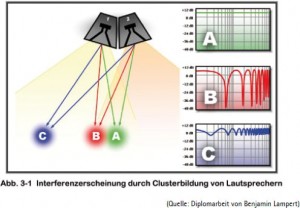 Introducing line arrays led to a reduction of individual speakers up to one quarter which provided additional resources for lighting and video technology. With the introduction of the DMX protocol in 1990, it was especially the concurrent digitization of the lighting technology that considerably benefited from the smaller and lighter sound reinforcement systems.
Introducing line arrays led to a reduction of individual speakers up to one quarter which provided additional resources for lighting and video technology. With the introduction of the DMX protocol in 1990, it was especially the concurrent digitization of the lighting technology that considerably benefited from the smaller and lighter sound reinforcement systems.
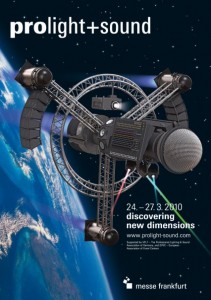 Before prolight+sound we were wondering, which products would draw the attention. Now, after a successfull show, we know it. Here are the top ten products of the prolight+sound 2010:
Before prolight+sound we were wondering, which products would draw the attention. Now, after a successfull show, we know it. Here are the top ten products of the prolight+sound 2010:


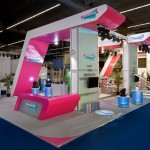
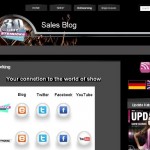 Those who have followed us last year, have certainly recognized some changes. On the homepage of our shop are for examples some recent tweets shown that provides you with news from our company. But there is just a selection of information reported. The whole informationtail you can look up directly on our diffrent Twitter-Accounts. Here we collected our news for you in german and as well in english. If you don’t have a Twitter Account yet and don’t want to miss out on our news you can just read them easily as a RSS-Feed in your prefered Feed-Reader.
Those who have followed us last year, have certainly recognized some changes. On the homepage of our shop are for examples some recent tweets shown that provides you with news from our company. But there is just a selection of information reported. The whole informationtail you can look up directly on our diffrent Twitter-Accounts. Here we collected our news for you in german and as well in english. If you don’t have a Twitter Account yet and don’t want to miss out on our news you can just read them easily as a RSS-Feed in your prefered Feed-Reader.


 Line arrays have dominated the sound transmission in modern entertainment technology of music festivals and international sports events for more than ten years now. These sound reinforcement systems can easily be identified by their slightly bent shape which is a reason why they are sometimes called „bananas“ in colloquial speech. More and more, line arrays can be found at smaller venues like medium-sized concerts and political events. This opens the market for more compact systems with easy handling and modest costs in order to operate in a profitable way.
Line arrays have dominated the sound transmission in modern entertainment technology of music festivals and international sports events for more than ten years now. These sound reinforcement systems can easily be identified by their slightly bent shape which is a reason why they are sometimes called „bananas“ in colloquial speech. More and more, line arrays can be found at smaller venues like medium-sized concerts and political events. This opens the market for more compact systems with easy handling and modest costs in order to operate in a profitable way.